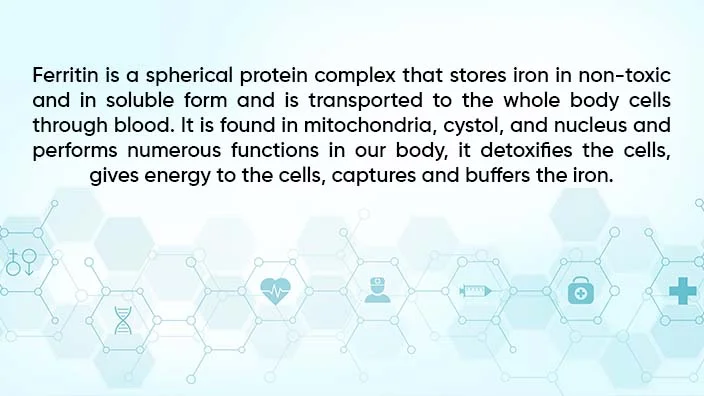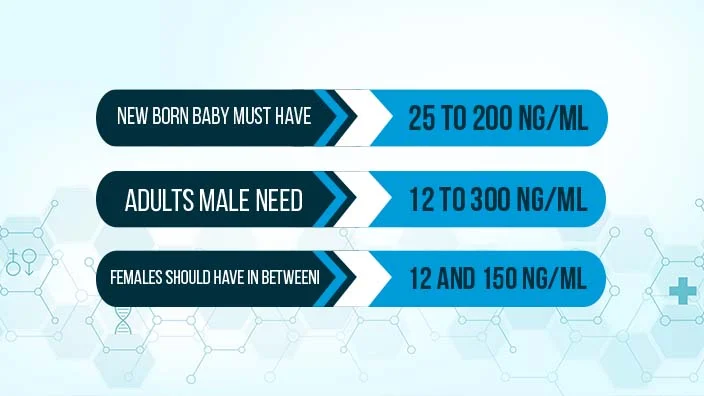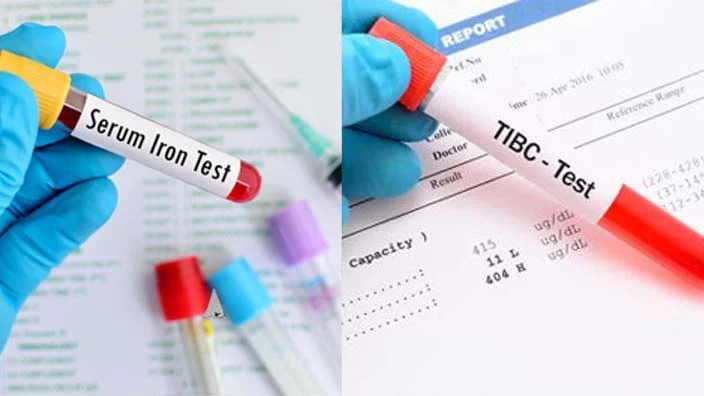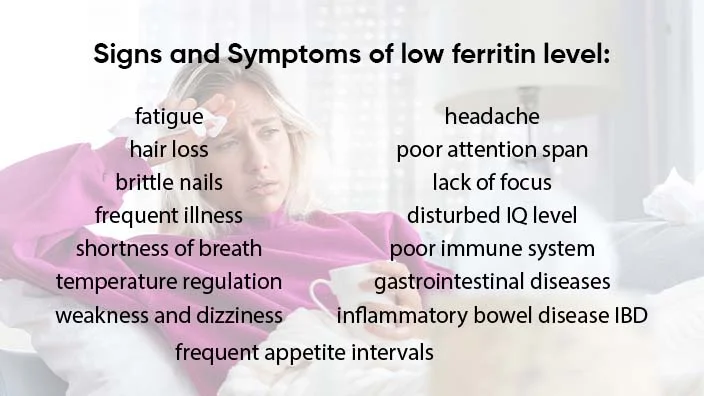Ferritin, the most important component of our blood, is found in tissue and cells of everywhere in the body. It is also referred to as the blood protein comprised of iron, a spherical protein complex that stores iron in non-toxic and in soluble form and is transported to the whole body through healthy red blood cells.
The body needs a proper amount of iron and ferritin and the increase or decrease of the optimal level may harm the body to unimaginable limits. To cope up such issue we have to find out how to increase Ferritin level. This article discusses methods of raising the ferritin levels.
Table of Contents
What Is Ferritin?
Ferritin is a spherical protein that stores iron in non-toxic and in soluble form and is transported to the whole body cells through red blood cells. Iron is an essential component of our blood.

It shows the level of iron in our body, and its level decrease and increase with the passage of time according to the situations. It can be assumed that Ferritin is the iron stored level in the blood cells, particularly in the red blood cells.
It is not always useful for the body, sometimes it can be toxic and of producing the reactive species which can damage DNA and protein. It is associated with number of diseases like iron deficiency anemia, shortness in breath, chronic fatigue, muscles problems, hair loss and skin problems.
Functions of Ferritin
Ferritin is an essential part of our body and performs inevitable functions in our body. The importance of the Ferritin is evident of the diseases it causes when it lowers or increases as national library of national heart and blood institutes wrote in American journal.
The most vital function of the ferritin is storing iron and transporting it to cells of the whole body. Many a times, it has been asked how to increase ferritin levels or how much iron is needed.
Ferritin inside the blood cells comprises of small amount of iron and can carry only limited amount of iron. It protects cells form the oxygen reactive species by detoxifying them; these reactive species have the power to damage the cells.
Optimal Ferritin Levels
Optimal level is the best working level that is necessary for the effective functioning. The optimal Ferritin levels ranges from “30 to 40 Nano grams per milliliter”, human body works better with this amount of iron and the increase or decrease may cause severe diseases.

This optimal range varies from individual to individual, females as compared to males are most likely to suffer on account of their heavy menstrual or monthly periods resulting in low hemoglobin levels.
In their reproductive age they have low hemoglobin, they need Ferritin more than males to rise their low hemoglobin and iron levels, particularly in their pregnancy.
According to WHO 30% of the world population are suffered from iron deficiency anemia and bear the consequences in the form of different diseases.
This optimal range varies from human to human, c Females as compared to males are most likely to suffer more on account of their higher need, and they need Ferritin more than males, particularly in their pregnancy.
Daily Recommended Dietary Allowance
The optimal range or level of Ferritin discussed in the previous section must be maintained at any cost in the body. The question arises is that how much iron is needed for every individual to keep the level balance.
The recommended dietary allowance (RDA) for iron suggests the ratio for the daily dose of iron intake. It should be 18 mg per day for the women of age 19 to 50 years, if they more than 50-year-old they may need 8 mg per day, less than 18 mg per day.
The women who are pregnant or lactating women required to intake more iron content which ranges up to 27 mg per day. Men may need 8 mg as their daily intake. For women, getting ferritin more than the optimal range won’t be a problem.
Related Article: How to Clear Histamine from Body
Ferritin Deficiency
If the above mentioned range increases or decreases, we call it abnormal ferritin levels. The optimal range very often increases but most of the times it decreases and causes the iron deficiency in the body.
It could be determined through the signs and symptoms, like fatigue, temperature regulation, weakness and dizziness, poor immune system, frequent appetite intervals, frequent illness, shortness of breath, brittle nails, hair loss, headache and many more.
It does not necessarily mean that it must be the iron deficiency. Sometimes other issues like low hemoglobin levels and diseases may overlap the above mentioned signs. However, the most appropriate method is laboratory blood test or ferritin test.
Testing Ferritin Level
As discussed earlier that the most appropriate method would be the laboratory testing on account of the following reasons; it would be particularly conducted to examine the Ferritin levels and would give the most accurate results.
The test will show whether your intake is low or you have any other abnormality that decline the iron levels. Only the laboratory blood test can give you the accurate results, avoid believing in mouth sayings.
Actual need of increasing ferritin level can only be judged through the lab reports, due to the reason that while relying on mouth sayings or signs; you may get misguided.
The signs and symptoms can only indicate the worst situation and signal you to visit a laboratory or your physician and to get more iron rich foods.
Differences between Iron and Ferritin
People often misinterpret the term ferritin with iron and use it interchangeably but the case in not so, both are very much different. Iron is an essential carrier of oxygen in the blood cells, carry oxygen to the cell and is considered is a mineral.
It is associated with different kinds of growth in the body like cellular, neurological, mental and physical. Lack or iron deficiency causes inevitable diseases.
While Ferritin is a spherical protein complex that stores much iron in non-toxic and in soluble form and is transported to the whole body cells through blood, particularly in the red blood cells.
It shows how much iron is in our body, and its level decrease and increase with the passage of time according to the situations. It can be assumed that Ferritin is the stored level of the elemental iron in the blood.
Ferritin Level Tests
As mentioned that there are very obvious signs and symptoms but that do not necessarily mean iron deficiency. So, the tests conducted in the laboratories for the examination of ferritin level are the following:-

- Total Iron-Binding Capacity (TIBC)
- Transferrin
- Serum Iron Test
Why to Increase Ferritin Level
As discussed that mostly the iron levels lower and cause different diseases, the tests are also discussed and let’s have a glimpse over the low ferritin level.
If your ferritin level is less than 12 to 30 hg/ml, you are much iron deficient and means that you are facing iron depletion or having depleted iron stores. You are then directed to increase your body’s ability to raise ferritin levels.
According to the reports of WHO more than 30% of the world population is facing the issue of iron deficiency anemia, either they are victims of malnutrition or they have some disease that hamper the iron production.
How can you detect that you have low level of Ferritin? The answer is quite simple if you have fatigue, dizziness, nausea, etc. these are the common symptoms indicating iron deficiency and you should conduct a test in a laboratory and visit a physician.
Causes of Low Ferritin Level
People often believe in the symptoms or mouth sayings. As mentioned in the previous sections that you can get satisfactory results through laboratory tests, no one can guide you better than that.

It is worth mentioning that why these problems frequently occur? Determining the root cause of no iron stores we can cope up the issue. The major causes are the following: -
- Determining Medical Conditions
- B. Poor Nutrition Lowers Ferritin Level
- C. Lack Of Exercise Causes Decline In Ferritin Level
- D. Taking Tea, Coffee and Smoking And Excessive Alcohol
- E. Lack Of Adequate Rest And Sleep
- F. Dearth Of Hydration
Signs & Symptoms of Low Ferritin Level
The signs and symptoms that reflect low iron intake are; chronic fatigue, temperature regulation, weakness and dizziness, poor immune system, frequent appetite intervals, frequent illness, shortness of breath, brittle nails, hair loss, headache and many more side effects of low iron levels.

Among the common side effects of low iron levels, the major one is fatigue; your body will be unable to raise energy levels and will get tired immediately. It will lead to the shortness of breath and heart failure.
Females during their pregnancy or heavy menstrual bleeding will have low iron intake side effects and may get complications in their delivery. If our diet remains unchecked or we take malnutrition, the fewer side effects may become severe cases.
People with Developing Iron Deficiency
The people who have increased risk of the iron low levels are the athletes, pregnant women, vegetarians, people have malnutrition, premenopausal, etc.
The bodies of athletes are always in runs, during the heavy work outs they loss vital nutrition, vitamins and other minerals. Female athletes are more prone to overall health issue particularly due to heavy periods.
The premenopausal women also loss blood during their excessive bleeding so they are more prone to low iron levels. The people who do not get the balance diet also have the scarcity of iron and its side effects.
Last but not the least, the vegetarians who only consume nonheme iron in the shape plant based foods or vegetarian sources of iron are likely much iron deficient. The female athletes are three times increased risk of the low iron levels.
Increasing Ferritin Levels
Addressing all the issues, the main concern is how to increase ferritin levels or how much iron should be taken. So it can be done through certain medications like iron pills, animal foods and plant foods, dietary supplements, oral and iv drips and injections etc.
Healthcare professionals of Cleveland clinic and National Institutes suggest the following are a few ways to raise low levels of Hemoglobin and levels of iron and ferritin levels: -
A). Medicated Iron Intake
The widely accepted but not always recommended way is the intake of iron through medications. People may take ferrous sulfate, ferrous gluconate, ferrous fumarate and iron supplements, the most bioavailable form, either orally or injected through syringes.

All the ways are good but the most instant. Consuming iron based food like animal foods are the gradual intake of iron. For instant iron intake healthcare professionals of Cleveland clinic and National Institutes recommend dark chocolate.
The medicated way is not always recommended because it leads to numerous medical issues like Crohn's disease, ulcer, abdominal pain, stomach pain, nausea, headache, digestive upset etc.
i). Taking Oral Iron Supplements
The bioavailable form of oral iron supplements is prescribed for the minor situation, if there is very low needed iron. If you take iron orally the level will be raised in just a week.
This way of taking gentle iron supplement is not effective on account of the involved risk of stomach ulcer. So you can take it orally but only in very small amount. You can also drink the iron rich juice available in the pharmacies and stores.
ii). Injecting Intravenous Vitamin
If the body has fallen to the lowest level and there is no option left then iron is injected through syringes, national heart and blood institute write in American journal.
If you have a lot of blood loss and your body is not able to absorb. It happens while, gastrointestinal bleeding, surgeries or accidents happen then the blood institute pass vitamins and iron through drips and intravenous iron injections.
iii). Visiting a Doctor
The best way is to visit a doctor, if you have any sign or symptom immediately consult a doctor and he/she will direct to do some tests and then will prescribe some iron supplements.
B). Iron Intake Through Diet
The most common method is the taking iron through diet, if you are not in a critical condition and either you feel tired or your doctor prescribe you, for your well being the healthy diet is food based.

Healthcare professionals of Cleveland clinic and National Institutes recommend that in either case you are directed to increase iron levels through iron rich foods, avoid excess plant foods that has non heme iron and almost no iron.
National Institutes and healthcare professionals of Cleveland clinic can provide you the best for your overall well being and overall health.
The best thing about taking iron through diet is its well being of no unpleasant side effects while taking iron supplements on empty stomach may cause iron toxicity resulting in headache, stomach pain, abdominal pain, nausea, gastrointestinal etc. diseases.
i). Eat Meat and Fish (the best source)
The first and foremost way to increase iron through diet is eating iron rich foods or iron rich meals like meat and fish. Red meat is iron rich and iron is easily absorbed from the meat, same is the case with salmon and fish contain heme iron.
These are the sources of iron which is readily absorbed to the blood cells and personal needs are fulfilled. These sources of iron, Meat and fish are comprised of myoglobin and the digestion of that gives dietary iron to the body. So animal proteins, meat and fish like iron rich food raise the ferritin level.
ii). Ingesting Plant Products
The leafy greens and plant based products are the secondary sources of dietary iron, these have non heme iron and cannot absorbed directly. The better absorption of non heme needs some factors like stomach acid, vitamin C etc.
These are the good sources of iron but not always recommended, you can consume such products but not always. In order to get beneficial effect do not only depend on these products, use animal based foods or animal based source of iron.
People consuming only nonheme iron found in plant products also have the low level of iron. The plant dietary sources for dietary iron intake are spinach, wheat, oats, rich beans etc. Plant itself is not iron rich, contains nonheme iron and its products are not a good sources of iron.
Add plant based products which are the sources of non heme iron like bell peppers, spinach, etc. to your iron pot cooking and cast iron pan in order to replenish iron stores.
C). Iron Intake Through Vitamin C
The tertiary sources of taking iron are the vitamins. Vitamin C also called ascorbic acid improve iron absorption from iron rich food. So it is the sources of increasing both heme iron and non heme iron ferritin creation.
Vitamin C is mostly found in orange juice and citrus fruit, so you need to take iron supplement and calcium supplements with citrus fruit juice like orange juice. The source of non heme iron bell pepper also contains Vitamin C.
D). Iron Intake Through Vitamin A and Beta-carotene
Besides vitamin C and iron rich food, Vitamin A is also helpful for the provision of dietary iron to the body. Iron reserves with Vitamin A is very effective for the treatment of Anemia.

Beta-carotene as the precursor of Vitamin A increase absorption of iron to the blood cells. Beta-carotene overcome the inhibitors like Polyphenols, Tannins and Phytates and ensures the smooth flow of iron to the body.
E). Avoid Foods & Minerals That Hamper Iron Absorption
Sometimes people take good diet but still face the low iron levels over a decade. The excessive consumption of tea and coffee may also hamper the iron levels, tea contains polyphenols that inhibit the iron absorption and causes digestive upset.

Coffee is comprised of chlorogenic acid, cocoa and other things, black tea contains tannins that also declines iron reserves. Excessive smoking and alcohol consumption are the causes of low Ferritin level as well.
So, you should stop taking certain foods, instantly tea and coffee after having meals to avoid low levels of ferritin. Levels of ferritin varies depending on different types of iron like heme iron as well as non heme iron.
Conclusion
To sum up, Ferritin is a spherical protein complex that stores iron in non-toxic and in soluble form and is transported to the whole body cells through blood, particularly in the red blood cells.
It shows the level of iron in our body, and its decrease or increase ferritin levels with the passage of time according to the situations. Almost every seventh person has the low level of iron, so how to increase ferritin levels is a big issue and a frequently asked query.
People often have symptoms like fatigue, headache, dizziness, nausea, hair loss, brittle nails and many more.
There are several ways like taking heme iron like meat, fish and salmon, plant products which are the sources of another type of iron, non heme iron, iron supplements, dairy products and other things like Vitamin C and A fuel the iron absorption to the blood.
Frequently Asked Questions
How can I raise my ferritin levels fast?
You can raise the ferritin levels by taking heme iron like meat, fish and salmon, plant products as non heme iron. Supplements and other things like Vitamin A & C, drips and injections fuel the iron absorption to the blood.
How quickly can ferritin levels rise?
If you have excessive blood loss, then it can be rise very quickly through injections. If the case is not too much severe it can be rise in 2 to 3 weeks through dietary supplements.
What vitamin increases ferritin levels?
Vitamin C speed up the iron absorption from food. it is the sources of increasing both iron dependent and iron independent ferritin creation. Vitamin A and Beta-carotene also fuel the iron absorption to the blood.
How do you treat low ferritin levels?
Treat low ferritin levels through taking meat, fish and salmon, plant products as non heme iron, supplements and other things like Vitamin A and C, drips and injections are also helpful for the low ferritin levels.


















